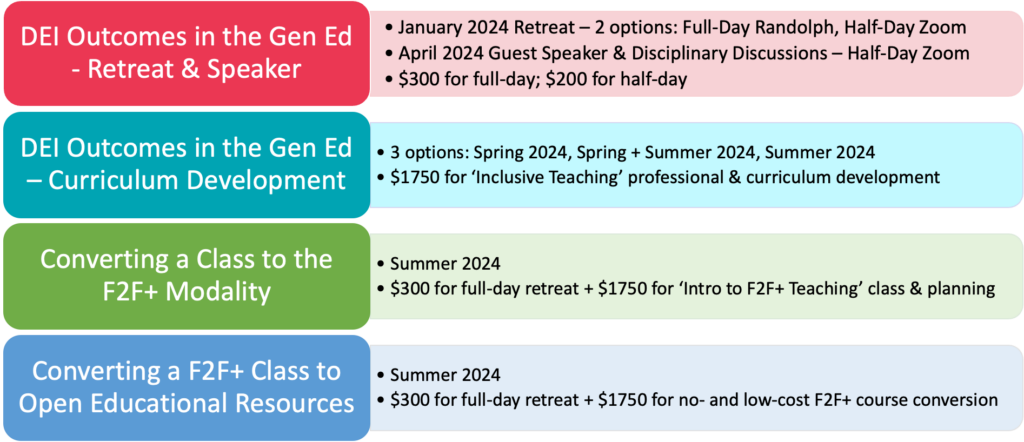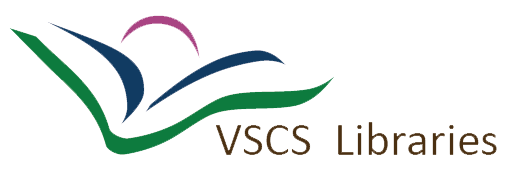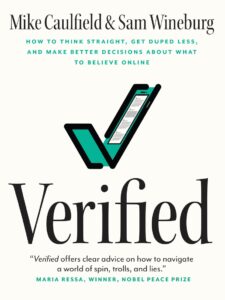December 2023 | Issue 5 | Volume 1 | Previous Issues
December Updates from the CTLI
The content of this newsletter focuses on Information and AI Literacy. It is hard to believe that ChatGPT came onto the scene only a year ago – the fast spread of generative AI tools and uses is almost mind-boggling. The VSCS Teaching & Learning with Technology (TLT) supercommittee is currently being restructured to include an “Emerging Technology” subcommittee, whose focus in the near future will be related to generative AI, including compiling resources for faculty. It is becoming clear that an important role of colleges is to help students be informed about AI and how to use it responsibly and ethically. The CTLI looks forward to being part of this new subcommittee. In the meantime, there are some basic teaching resources related to AI in this newsletter.
And information literacy is a key component of informed, responsible, and ethical use of AI, but of course, not restricted to AI-generated content. As we approach a general election year, supporting students to evaluate and use valid information is especially important. The library liaisons are eager to work with you and your students to develop these skills. You can find comprehensive information about library services for faculty in this newsletter, as well.
Spring & Summer 2024 Paid Professional Development Opportunities
The CTLI is pleased to announce multiple paid opportunities for professional development, upcoming in Spring and Summer 2024. We recognize that faculty are being asked to do a lot of work related to course design and teaching, which requires hours of time, effort, and research. We are committed to supporting you with these efforts and procuring/steering funding for reasonable compensation.
Details about all four opportunities are outlined in these slides.

DEI Outcomes in the Gen ED
As you likely know, part of the phased-in Gen Ed requires diversity, equity, and inclusion (DEI) outcomes in the Gen Ed, starting in Fall 2024. With the endorsement of the Faculty Assembly Gen Ed committee, the CTLI is is offering paid opportunities to support this work through the generous support of the Castleton Title III grant.
Please RSVP for a January 2024 retreat (offered twice – once on Zoom and once in Randolph). The agenda for this session is still under development, but session topics may include: Refamiliarizing with the Gen Ed DEI program and breadth outcomes, Strategies for engaging in difficult dialogues in the classroom, and Setting collective intentions: Why does DEISJ in the Gen Ed matter?
Please apply with a team of colleagues by 12noon on January 24 to develop course-level outcomes, content, and learning experiences for your Gen Ed course(s). Selected teams will take an Inclusive Teaching course and then use what they’ve learned to plan their fall Gen Ed courses. There is funding for 32 people to participate.
F2F+ Teaching
The CTLI applied for a new round of funding for a project titled “Prioritizing Access Through ‘Face-to-Face Plus’ Expansion + OER Adoption,” and we were notified in the past week that our application was approved for $216,261, the bulk of which is allocated for faculty stipends. The grant was received from the Davis Educational Foundation established by Stanton and Elisabeth Davis after Mr. Davis’s retirement as chairman of Shaw’s Supermarkets, Inc.
Please apply as an individual by 12noon on February 21 to convert a course to the F2F+ modality. Selected individuals will take a 4-week synchronous course in June 2024, during which they’ll map out the outcomes, assessments, and learning activities for a F2F+ course then design lesson plans for teaching in the F2F+ modality. Additional support will be provided for effective integration of technology. Faculty who have participated in this program in the past are eligible to apply, as long as you are converting a new class that you haven’t previously converted.
Please apply as an individual by 12noon on February 21 to convert an existing F2F+ course to no- or low-cost textbook/materials for students. With support of librarians and CTLI staff, you will explore existing Open Educational Resource (OER) materials to adapt or adopt; if no relevant materials exist, you will have the opportunity to create your own (or some combination of adoption, adaptation, and creation). Faculty who have adopted OER in the past have appreciated the ability to customize content to suit their outcomes, students, and interests. Students appreciate the emphasis on affordability.
There are stipends to support 40 faculty between these two Davis Educational Foundation-funded opportunities.
We look forward to working with you in the coming months on these projects.
January Newsletter
As an FYI, our January newsletter will be abbreviated and published on the 3rd Monday of January instead of the 1st Monday, given the upcoming winter break.
With deep appreciation for the work of Vermont State University’s faculty,
Jen Garrett-Ostermiller
CTLI Director
Generative AI in the Classroom – A Faculty Perspective

This month, Keith Tookey, a Randolph-based Associate Professor of Computer Information Systems, shared his perspectives on the use of generative AI in the classroom.
Keith, please tell us a bit about your background and the courses you enjoy teaching at VTSU.
I am a generalist for teaching, but I particularly enjoy Software Engineering, Database, Operating Systems, and special topics classes. Of course, I have enjoyed every single class I have taught in Vermont, not to mention other classes I have taught since I started teaching back in 1981.
I also have a background in Artificial Intelligence and even participated in the State of Vermont’s Task Force on AI. In addition, I’ve been part of a Vermont email group exploring ChatGPT and the classroom and you are welcome to email me if you would like more information about the group. Given all of my involvement in AI driven initiatives, perhaps it is surprising that I, personally, do not use generative AI in my classroom!
What advice would you give to colleagues who have concerns about AI and its impact on academic integrity?
I understand a lot of people have legitimate concerns about AI, especially with regard to academic integrity. While I am happy to provide resources to people who want to know more, I have one major piece of advice to people who are concerned about AI assisted cheating: Have more interactions with your students. The more you interact with your students, the easier it is for you to notice when the quality of their work changes. The more you interact with your students, the deeper learning tends to occur. Especially in the modern era of ZOOM, students need more interaction, not less.
How have you changed your own instructional methods to increase student engagement and reduce the potential impact of AI on academic integrity?
I have modified my teaching by adopting a flipped classroom methodology; I record traditional lectures, and use class time to do interactive exercises and projects. As a result, AI won’t be helpful in a live small group session with student peers. Checking in with students during the process makes it difficult to submit a whole paper they do not understand. And, ultimately, most students in my field learn quickly that they have to actually be able to do the work to succeed.
For instructors who choose to integrate AI usage in the classroom, I’d suggest reading the University of Central Florida’s recommendations for re-envisioning how we assign college writing and projects.
Beyond instructional considerations, the inclusion of an AI-specific policy statement has been a topic of discussion amongst educators. Do you include a generative AI policy statement in your course syllabi?
I do not have an AI policy statement in my syllabus. However, I have a very clear statement that students must report any sources used. If I do catch someone handing in work from an unreported source, that gives me the ability to report the problem, if needed.
To learn more about Professor Tookey, his Vermont State profile includes additional information about his background as well as a list of his previously written publications.
University Partner – The VSCS Libraries
Over the last six months the VSCS Libraries have worked to create and expand services to benefit faculty, staff, and students across the system. Your engagement and feedback are crucial, and they look forward to collaborating with you!

Our Current Projects
- Workshops ranging from general library services including information literacy to specialized workshops geared toward specific subject areas. Check out our recorded workshops. We plan to host new workshops in the spring. Send us recommendations for workshops!
- Library Learning Objects that can be embedded in your Canvas classes. These include:
- Pre-built learning modules to embed in your Canvas course. These learning modules include different instructional tools including citation guides, plagiarism material, and more. Are you looking for a subject specific learning module to embed in your course? Contact your liaison librarian.
- Credo Reference InfoLit modules to embed information literacy into your courses. Reach out to your liaison librarian to learn more! Have you used Credo InfoLit? Please submit your feedback here!
- Teaching Resources to help guide students through their biggest assignments:
- See the How to Do Research section of the library website for an overview of the research process.
- Check out our new APA Cheat Sheet. More VSCS Libraries Cheat Sheets to come!
- 24/7 Chat Reference to help students and faculty with their research and teaching. Help is provided by VSCS librarians during peak weekday hours and by professional librarians from other institutions after-hours and on the weekends. (Help is also available by phone, text message, email, or in-person at our library locations.)
- Consolidated Library Website providing access to a comprehensive collection of electronic resources, as well as extensive instructional content. We are currently testing our website to make sure it works well for all our users. Sign up here if you are interested in taking part.
- Focused, Up-to-Date Print Collections. We are working on modernizing and streamlining our book collections across the system. Your liaison librarian will be in contact with you regarding our collection management strategies and how you can help us improve the collection. If you have any book recommendations or requests, please let them know!
Your feedback is instrumental in guiding our efforts and ensuring that we continue to meet the evolving needs of the VSCS community. If you have any ideas that can help us improve our services and resources, please connect with your liaison librarian.
Learn more about the VSCS Libraries at https://libraries.vsc.edu.
Teaching with Generative AI
Have you been hearing and reading about ChatGPT? Are you contemplating the big questions being raised about implications for higher education? Do you have feelings (or a range of feelings) about how this technology will impact your classroom and assignments? As with any new technology, there is a lot to learn and consider. While many thought leaders are sharing valuable perspectives, we wanted to distill some useful information for you.
What is ChatGPT?
ChatGPT is an artificial intelligence software that composes answers to user-submitted questions or prompts. It relies on a database of billions of words (scraped from the internet, prior to 2022) and has been trained by humans to generate a sequence of words that mimic human writing and conventions. It can also revise its output, based on clarifying ideas or questions or prompts, adjusting the content or tone or style of its generated answers. The term “intelligence,” however, is a bit misleading. The responses ChatGPT generates often include false or unreliable information. Additionally, ChatGPT lacks the ability to analyze (since it is just predicting text), and it also cannot provide information about current events (it’s dataset currently maxes out at 2021).
What are some other examples of Generative AI apps?
GPT-4
GPT-4 is the newest version of OpenAI’s language model systems, officially launched in March 2023. It is a multimodal model, in that it accepts text and images as input. It can only generate text. It has demonstrated much stronger academic performance compared to the GPT-3.5 model.
After the release of GPT-4, Microsoft officially confirmed that Bing runs on OpenAI’s GPT-4 model.
Dall-E 2
Dall-E 2 is ChatGPT’s visual creation sister, which is also run by OpenAI.
Bard
Bard is Google’s AI chatbot. It is available through waitlist, although the wait is usually only a few days. It is still in beta-testing stage and performs with obvious lapses, but appears to evolve constantly.
Guidance for Teaching with Generative AI
Teaching and learning in the era of generative AI does not need to be all about damage control. Plagiarism and ethics concerns are real, but on the other hand, the advance of generative AI gives us a special opportunity to focus on the challenges of teaching and work out strong solutions.
Generative AI itself can be a learning tool– as anyone who gets into the tool and starts inputting queries and studying the output knows. Your synapses are firing as you write and read the rapidly generated text. It’s fun, and you’re likely wide awake, judging, speculating, disagreeing, agreeing, and doing all those things that happen when an engaged reader encounters text. These potentials can be used in the classroom.
Some specific suggestions:
- Assignment Strategies: Authentic assessment, formative assessment, assessment add-ons like problem-solving logs, exam wrappers, minute papers, “muddiest point” questions.
- Ask students to use diverse media. Replace an essay or short-answer writing assignment with one that requires students to submit an audio file, podcast, video, speech, drawing, diagram, or multimedia project.
- Create connections to real-world experience that AI will not have. Connect assignments to very recent events or new conversations in the field; to issues specific to the local community, or to discussions that took place in your own classroom. Alternatively, ask your students to find a connection between course concepts/topics and their personal experience or knowledge.
- Ask your students to reflect and plan as part of learning. Reflecting and envisioning a future are two areas where generative AI’s performance remains quite weak. Create space for reflection and sharing after each learning unit. Make reflection and planning a routine part of written assignments that is gradable. Students will not be able to create strong submissions for such tasks using generative AI (also, feel free to tell them just that!)
- Example: Instead of the traditional essay, which is now easy to cheat through, assign a multimedia project accompanied by a brief self-reflective essay.
- Incorporate ChatGPT in your assignments. The more familiar your students become with it, including both its strengths and weaknesses, the less likely they will be to use it blindly for generating submissions.
- Example: to develop your students’ critical thinking skills, ask them to generate a ChatGPT response to a question of their own choosing, and then write an analysis of the strengths and weaknesses of the ChatGPT response.
- Teach your students to cite generative AI correctly.
- Teach your students to use generative AI safely. ChatGPT acknowledges that they may share account holders’ personal information with third parties, including vendors and service providers. See Privacy Policy. Teach your students to never share personal and sensitive information with generative AI chatbots.
- Use social annotation. For short reading responses, instead of using open-ended questions in Canvas, try social annotation tools, such as Hypothes.is or Perusall, that require students to engage with a text along with their classmates.
- Extend Flipped Learning. Ask students to read, view, and digest material at home, and then apply, demonstrate, and perform in class, individually or in small groups.
Tips to Mitigate Cheating and Non-Learning
Using generative AI to create or enhance the content of submissions when an assignment does not explicitly call or allow for it is academically dishonest, akin to paying a person to write your paper, take your test, or complete your assignment. Here are some tips on preventing and addressing academic dishonesty in the era of generative AI.
- Talk to your students. The first step to addressing the projected or actual academic integrity issues in the classroom is to talk to your students about your expectations for academic honesty.
- Remind your students of the University’s policies.
- Add a clarifying statement to your syllabus.
- Give examples. Be specific and frank about your concerns.
- Raise questions to stimulate reflection: Why is academic integrity valuable and important to uphold? What’s the point of pursuing a degree, of taking a class, if you don’t learn?
- Make plagiarizing difficult. Use some of the assignment design strategies suggested above to create assignments that encourage honest work.
- Run your assignment through ChatGPT. If you assign a task that can be solved by ChatGPT, run it through ChatGPT first. Review the answer you receive, and tell your students about your experience. ChatGPT does not produce the same answer each time the same question is posed, but the outputs may still be fairly similar.
- Be on the lookout for AI-produced texts.
- Play around with the tool and get an idea of what kind of prose is produced to the questions you typically ask. Not only will you gain insights on how to better write your assignments, but you may get a sense of the “voice” — or lack of voice — of the tools.
- Make use of AI-detecting tools.
- Always consider students’ writing history and the broader context of the assignment before making a decision. When plagiarism is suspected, talking to the student individually is the easiest first step to addressing the problem.
Additional Resources
AI Guidance for Teachers – Yale Poorvu Center for Teaching and Learning
AI Guidance & FAQs – Harvard University
Artificial Intelligence Teaching Guide – Stanford University Teaching Commons
Getting Started with Generative Artificial Intelligence – University of Michigan
Citation
Citation: Practical Responses to Generative AI. Montclair State University. Retrieved September 27, 2023 from https://www.montclair.edu/faculty-excellence/teaching-resources/clear-course-design/practical-responses-to-chat-gpt/.

This teaching guide, which has been modified from its original form, is licensed under a Creative Commons Attribution-NonCommercial 4.0 International License.
Recommended Literature

A new book has come out by Mike Caulfield and Sam Wineburg called Verified: How to Think Straight, Get Duped Less, and Make Better Decisions about What to Believe Online. This text is written for a broad audience (including students and faculty) with accessible language and concrete examples.
Mike Caulfield developed the SIFT method for information literacy, which stands for Stop, Investigate the source, Find better coverage, and Trace claims, quotes, and media to the original context. We’ve seen faculty use this method with first-year college students and echo Caulfield & Wineburg’s observation (from Chapter 1 of Verified) that the issue of evaluating information online is not a deficit in critical thinking but the need for strategies that help students contextualize the information.
Caulfield & Wineburg’s book is relevant to the current media and cultural landscape. They point out in Chapter 1 that rather than debating whether something is true or false, their goal is to equip readers (and students) with the skills to identify if information is valid or invalid. They explain and promote techniques such as effective use of Google search, lateral reading, leveraging Wikipedia, and analysis of videos for common manipulation. An emphasis on the individual (the consumer of information) as an important contextual factor encourages self-reflection on emotional aspects of encountering information online.
The library has a copy of this book on order and will be well worth your time. If you are interested in brainstorming ways to incorporate strategies from this text, please don’t hesitate to reach out to the Center for Teaching & Learning Innovation staff or your library liaison (see above for librarian contact information).
Reminders for Student Success

The end of the semester is drawing near and the Center for Teaching & Learning Innovation would like to share several recommendations related to student responsibility and success.
In addition to verbal reminders, emailing and posting the information as announcements in your Canvas sections could be advantageous.
Encourage students to check their email often to make sure they don’t miss any important messages. Beyond the emails sent by their instructors, they might also receive time sensitive information pertaining to schedules, financial aid, and other administrative matters. A small reminder could make a difference in terms of their overall success as a student.
Reiterate end-of-semester course deadlines and policies regarding the acceptance of late work. Time management is key to student success and proactive behavior on their part should be encouraged.
Remind students to check their grade books toward the end of the semester and following it.
Encourage students to contact their advisor if they have questions about their future with the university.
Remind continuing students to submit the FAFSA (Free Application for Federal Student Aid) if they haven’t done so already.
Additional Ideas and Recommendations
Ending the Semester – Georgetown University: Center for New Designs in Learning and Scholarship
How to End a Course: Teaching Tips – Washington University in St. Louis: Center for Teaching and Learning